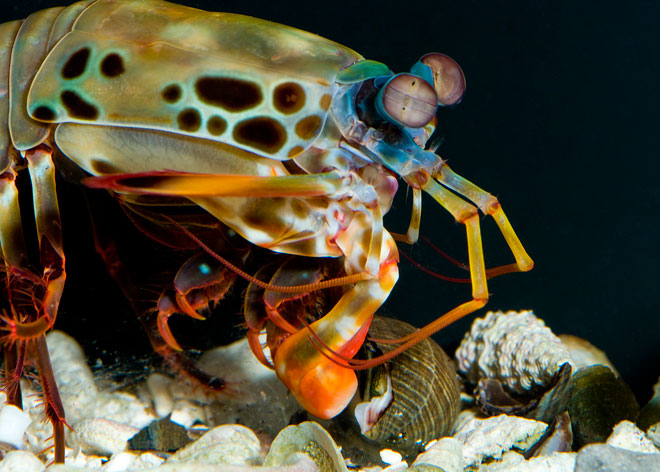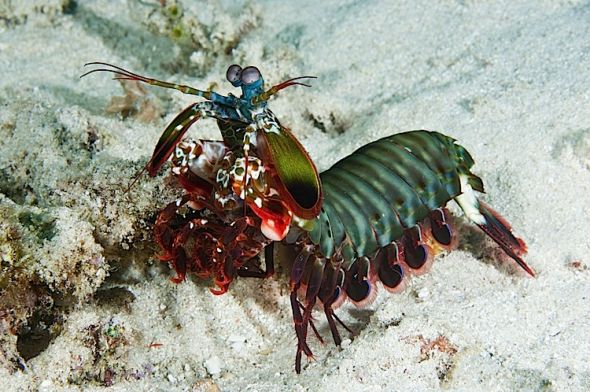Not So Mr. Nice Guy
Odontodactylus scyllarus may look small but it sure does pack a punch when it needs to. The way the peacock mantis shrimp interacts with other organisms is one of a kind and the methods they use are like none other you have seen before. These peacock mantis shrimp aren’t the type of shrimp to let other organisms come and take over their area and home. They are extremely territorial and have multiple ways of defending their precious home and territory (National Aquarium 2014). Although, they aren’t the sharing type, they are known for doing a good deed for other organisms that need a home. Peacock mantis shrimp quite often create new burrows and leave the old ones behind, which then help create a home for other aquatic animals seeking a place to live (Baxamusa 2010). Peacock mantis shrimp are extremely aggressive when protecting and hunting both during the day and night (“Odontadactylus scyllarus” 2012).
Peacock mantis shrimp has a very unique function in their
eyes, which are capable of seeing in ultraviolet, polarized
light, and regular color through the structure in their eye know
as their stalked compound eyes (Claverie, Chan, and Patek 2011).
The vision they have is way more complex than the human
containing 12 different cells to the 3 of a human (Science and
Nature: Animals; National Aquarium 2014). This rare sight of
theirs is one of the many reasons that the Mantis Shrimp is such
a successful hunter. For example, the stalks on its eyes allow
it to make better observations when sizing up prey and predators
from the safety of the their burrows (Science and Nature:
Animals 2014; National Aquarium 2014). Sight isn’t the only
thing they have going for them, they also can communicate
through vibrations made by contractions in the posterior
muscles. This very unique function can be used for
territorial and defensive purposes, and they can generate these
rumbles while in their burrow that therefore warns off predators
or at least makes them keep their distance (Cronin and Marshall
2001). The artillery of amazing abilities doesn’t stop there the peacock mantis shrimp can also detect smells
while it is in the water (Cronin, Marshall, and Land 1994). (See
Form and Function)
Peacock mantis shrimp aren’t known to have many other aquatic
predators although, they have been found in large fish such as
the bluefin tuna (Thunnus thynnus) and barracuda (Sphyraena
barracuda) (Patek and Caldwell 2005). For the most part they don’t
have to worry about being preyed on too much because they are carnivores
and sit near the top of the food web. This depends on the size of the individual because if smaller they may
be prey for other fish. As for what they prey on includes: snails,
clams, crab, and many small fish. Another important thing to take
note of is how colorful the peacock mantis shrimp is. The visual
design can be used to communicate to not just other mantis
shrimp but also predators by flashing the colors, which
increases their conspicuousness (Science and Nature: Animals
2014).
This depends on the size of the individual because if smaller they may
be prey for other fish. As for what they prey on includes: snails,
clams, crab, and many small fish. Another important thing to take
note of is how colorful the peacock mantis shrimp is. The visual
design can be used to communicate to not just other mantis
shrimp but also predators by flashing the colors, which
increases their conspicuousness (Science and Nature: Animals
2014).
As for importance to humans there isn’t much connection
beside the fact that we can research and study them while they
are in captivity and learn more of the secrets behind their
amazing eyesight and the insane amount of power behind the claw
appendages. Likewise, there aren’t really any other effects on
humans but for uses, there is a Japanese cuisine where mantis
shrimp are eaten boiled as a sushi topping called shako. An
additional, fact is the peacock mantis shrimp is not considered
endangered or threatened ("The IUCN Red List of Threatened
Species" 2013).

